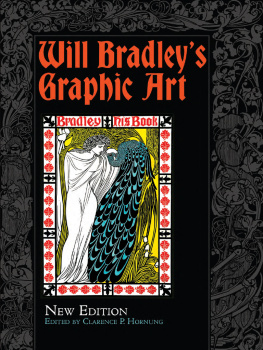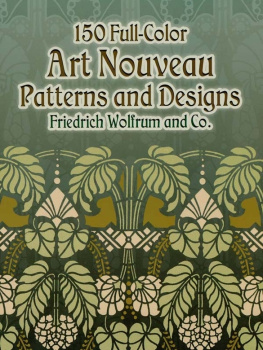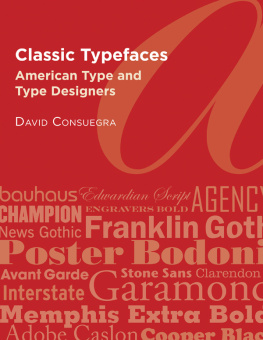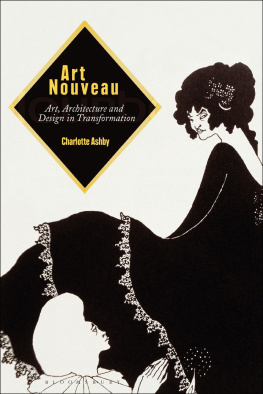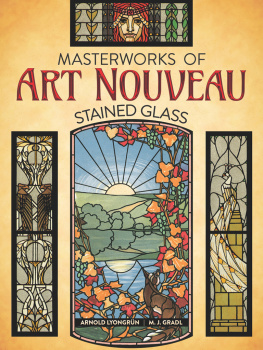Will Bradleys Graphic Art
NEW EDITION
WILL BRADLEY
EDITED BY CLARENCE P. HORNUNG
DOVER PUBLICATIONS, INC.
MINEOLA, NEW YORK
Copyright
Copyright 1974, 2002, 2017 by Dover Publications, Inc.
All rights reserved.
Bibliographical Note
This Dover edition, first published in 1974 as Will Bradley: His Graphic Art, and reissued by Dover in 2017, contains a selection of graphics by Clarence P. Hornung (sources of individual works are given in the List of Plates); Clarence P. Hornung and Roberta W. Wong wrote an introduction especially for the 1974 Dover edition. An autobiographical section (pp. xi-xxxi, Notes Toward an Autobiography) was originally published in the booklet Will Bradley: His Chap Book, The Typophiles, New York, 1955, copyright 1955 by Paul A. Bennett for the Typophiles, used by permission. An additional eight color plates have been added to the present edition.
Library of Congress Cataloging-in-Publication Data
Names: Bradley, Will, 18681962, author. | Hornung, Clarence P., 18991997, editor. | Waddell, Roberta, writer of introduction.
Title: Will Bradleys graphic art / Will Bradley ; edited by Clarence P. Hornung.
Other titles: Will Bradley
Description: New edition. | Mineola, New York : Dover Publications, 2017. | This Dover edition, first published in 1974 as Will Bradley: His Graphic Art, and reissued by Dover in 2017, contains a selection of graphics by Clarence P. Hornung; Clarence P. Hornung and Roberta W. Wong wrote an introduction especially for the Dover edition. An autobiographical section, Notes Toward an Autobiography, was originally published in the booklet Will Bradley: His Chap Book, The Typophiles, New York, 1955.
Identifiers: LCCN 2016038534| ISBN 9780486811291 (paperback) | ISBN 0486811298
Subjects: LCSH: Bradley, Will, 1868-1962Themes, motives. | BISAC: ART / American / General. | ART / History / Modern (late 19th Century to 1945). | DESIGN / Graphic Arts / Advertising.
Classifcation: LCC NC139.B7 H67 2017 | DDC 740.92dc23 LC record available at https://lccn.loc.gov/2016038534
Manufactured in the United States by LSC Communications
81129801 2017
www.doverpublications.com
Contents
Introduction to the Dover Edition
D uring the last years of the nineteenth century many respected artists turned to the creation of posters, pottery and glassware, elaborate needlework compositions and patterns for wallpapers and draperies. The current enthusiasm for handcraftsmanship and Art Nouveau, the style closely identified with the Arts and Crafts Movement, has encouraged many to turn to this earlier period, the 1890s, for artistic inspiration. Contemporary interest in the fin de sicle has led to the discovery of many artist-craftsmen whose work, out of favor for decades, has been neglected. Among those was Will Bradley, an American decorative illustrator and artisan who was esteemed in his own day as
... a craftsman, in the best sense of this much-abused word; one who seeks to beautify the essentially utilitarian; one of that sturdy band of artists who, walking in the humble path of their own choosing, make the hardest kind of a fight against bad traditions and the prevailing custom and prejudices of mere commercialism; and one of those who succeed in giving the charm and dignity of art to objects of common use.
Born in Boston, Massachusetts, in 1868, Bradley was fascinated by type, printing, and illustration as a child. When he and his mother moved to Ishpeming, Michigan, after his fathers death in 1879, he found a job as a printers devil and later was foreman of the local newspaper. He composed with type at work, while in his spare time he earned extra money by designing posters. In 1886 he moved to Chicago to begin his career as an artist. He soon found his forte as a pen-and-ink illustrator, and by 1890 his work was appearing in Frank Leslies Illustrated Newspaper and the Chicago trade journal, The Inland Printer.
Bradley did not have enough money to attend art classes during those early years in Chicago, and, instead, received his instruction from contemporary magazines, libraries, and local bibliophiles. Like many other self-taught artists of his day, he was quite aware of the latest developments in the art world, here and abroad. He must have read English and American essays on Japanese art and certainly observed how Eastern concepts of design were being assimilated into contemporary illustration and ornament. He studied British theories of art and decoration, such as those formulated by Owen Jones and Christopher Dresser. The Englishman who had the greatest impact upon Bradley and many of his contemporaries, however, was William Morris. Morris popularized the idea that the Arts and Crafts Movement had a mission. All the arts, from painting to furniture design, were to bring joy to the craftsman as he produced objects that, in turn, would make everyday life more beautiful. His firm, Morris and Company, a model for other craftsmen, created and sold wallpapers, fabrics, metalwork, furniture, and stained glass. Morris himself founded the Kelmscott Press, where he designed and printed many richly decorated books. The work of Morris and his followers became identified with a particular style of design; decoration was derived from nature, but was simplified, usually symmetrical, and often interlaced with curving lines.

Bradley was also aware of another emerging English art movement that had originated from ideas proposed by Oscar Wilde. This school embraced no lofty moral tenets, but revered art for arts sake. The English school of design associated with this philosophy was related to an art movement that was developing on the Continent during the early 1890s; asymmetrical compositions, strong surface patterns, and dominating curvilinear rhythms were hallmarks of both British and Continental Art Nouveau.
In his early illustrations and ornaments, Bradley acknowledged his debt to the work of contemporary American draftsmen, to members of the English Arts and Crafts Movement (including Herbert Home, Walter Crane, and William Morris), as well as his admiration for Japanese art. Although he realized a distinct sense of design by combining, as early as 1891, asymmetrical, curvilinear ornament with contrasting black and white areas, it was not until 1894 that his work dramatically matured into a thoroughgoing Art Nouveau style in a series of covers for The Inland Printer (). The catalyst, Aubrey Beardsleys illustrations for Le Morte d Arthur and Salom, inspired Bradley to achieve a new unity of design through increasingly expansive, curving lines and a subtle balance of bold, asymmetrical surface patterns and shapes. It would be most unnatural in a person so young and impressionable not to show evidence of numerous outside forces; at the same time, Bradley went beyond them and created something quite his own.
Bradleys posters and cover designs commissioned in 1894 marked the beginning of Art Nouveau in America, and along with the poster; that Edward Penfield executed for Harpers Magazine, initiated the poster craze in this country. The work of countless Bradley imitators appeared at the newsstands, book stores, and on billboards, and provoked considerable comment from the startled, yet often enthusiastic public. Some who admired the poster as an art form marveled at the growth and vitality of this class of design, while others, overwhelmed by the surfeit of placards, predicted its imminent demise. Bradley, who did not overestimate the importance of the poster as a new form, believed that it had a place in his role as an artist: My constant efforts have been to make better and more refined that art which walks hand in hand with business.

